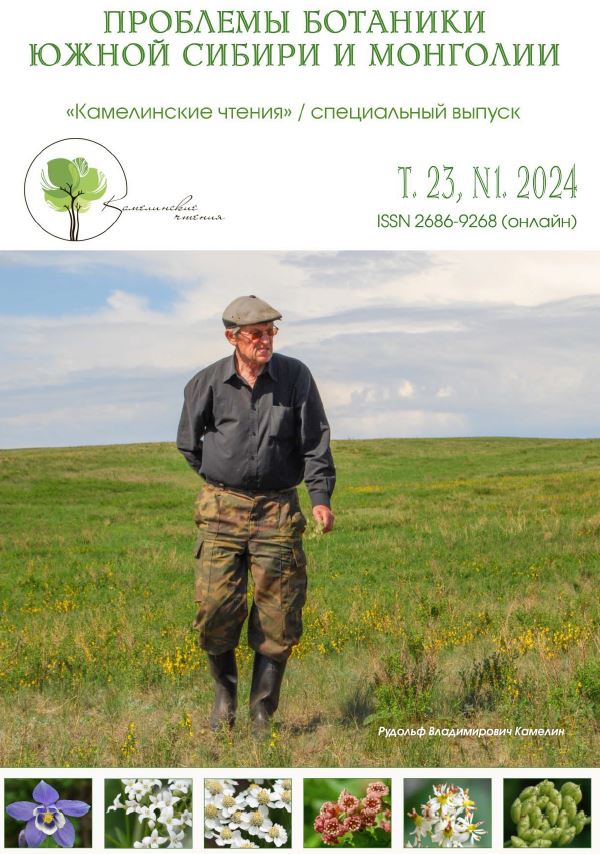Plastome DNA markers and phylogeny of certain poorly resolved groups of Hyacinthaceae
УДК 577.21:582.52
Abstract
Several genera of Old World Hyacinthaceae are still not fully resolved, with Scilla s.l. being the mostcontroversial, and there is no consensus about the content of Hyacinthus as well. We have obtained sequences of trnL-Fplastome region for Hyacinthus transcaspicus and Hyacinthella (Scilla) atropatana. ML phylogeny trees confi rm that bothCentral Asian species of Hyacinthus are nested within Fessia sensu F. Speta and only distantly related to H. orientalis.Our data place Hyacinthella atropatana away from most Hyacinthella species, in a sister clade with Nectaroscilla (Scilla)hyacinthoides. Th ese two species have very little in common regarding habit, so a detailed investigation of characteristictraits of these two and closely related taxons is needed to evaluate the reasonableness of merging the two into one genus.
Downloads
Metrics
References
Аверьянов Л. В., Аветисян В. Е., Аветисян Е. М., Агабабян М. В., Агапова Н. Д., Габриэлян Э. Ц., Айрапетян А. М., Мехакян А. К., Нерсесян А. Н., Оганесян М. Э., Таманян К. Г., Ханджян Н. С. Флора Армении / под ред. А. Л. Тахтаджяна. Т. 10. Monocotyledones (исключая Poaceae). - Ruggell, 2001. - 613 c.
Buerki S., Jose S., Yadav S. R., Goldblatt P., Manning J. C., Forest F. Contrasting biogeographic and diversification patterns in two Mediterranean-type ecosystems // PloS one, 2012. - Vol. 7, №6, e39377. DOI: 10.1371/journal.pone.0039377.
Davis P. H., Stuart D. C. Flora of Turkey and the East Aegean Islands. - Edinburgh: Edinburgh University Press, 1984. - Vol. 8. - P. 1-632.
Doyle J. J., Doyle J. L. A rapid total DNA preparation procedure for fresh plant tissue. // Focus, 1990. - Vol. 12. -P. 13-15.
Greilhuber J., Speta F. C-banded karyotypes in the Scilla hohenackeri group, S. persica, and Puschkinia (Liliaceae) // Plant Systematics and Evolution, 1976. - Vol. 126. - P. 149-188.
Oztidogru B., Aygoren U. D., Tarikahya H. B., Yildirim H. Phylogeny, biogeography, and character evolution in the genus Scilla s.l. and its close relatives Chionodoxa, Gemicia, Puschkinia and Prospero (Asparagaceae) // Plant Systematics and Evolution, 2022. - Vol. 308. - № 44. DOI: 10.1007/s00606-022-01835-x
Persson K., Wendelbo P. Taxonomy and cytology of the genus Hyacinthella (Liliaceae-Scilloideae) with special reference to the species in S.W. Asia. Part I. // Candollea, 1981. - Vol. 36. - P. 158-175.
Pfosser M. F., Speta F. Phylogenetics of Hyacinthaceae based on plastid DNA sequences // Annals of the Missouri Botanical Garden, 1999. - Vol. 86. - P. 852-875.
Speta F. Systematische Analyse der Gattung Scilla (Hyacinthaceae) // Phyton (Austria), 1998. - Vol. 37. - P. 120-125.
Stuart D. C. Chromosome numbers in the genus Muscari Mill. // Notes From The Royal Botanic Garden Edinburgh, 1970. - Vol. 30. P. 189-196.
Taberlet P., Gielly L., Pautou G., Bouvet J. Universal primers for amplification of three non-coding regions of chloroplast DNA. // Plant Mol Biol., 1991. - Vol. 17(5). P. 1105-1109. DOI: 10.1007/BF00037152. PMID: 1932684.



